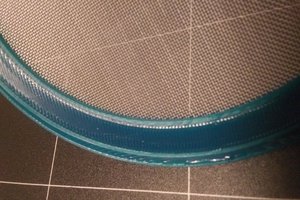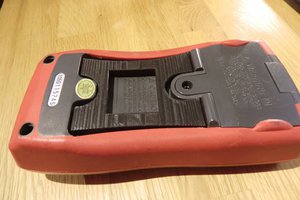The stock turn signal switch in the early models of the Corvair (1960 - 1964) can be quite finicky, often bumping itself out of alignment and thus not automatically canceling the turn signal when turning back from one direction. The turn signal mechanism in the late model Corvairs (1965 - 1969) was vastly improved, but is not a drop in replacement with the steering column in my '63. In order to install the turn signal system we liberated from a smashed 1965 Corvair, we had to chop the top of the steering column off my '63 and add the '65 parts to the end.
This worked quite well, with one small exception. There was a small plastic cup shaped part screwed onto the back side of the original '63 steering wheel that interfaced with two cams in the turn signal mechanism to cancel the turn signal after you have completed a turn. The plastic cup that came from the '65 steering wheel mounted differently to the steering wheel, so I couldn't use that piece, and I didn't want to use the '65 steering wheel, as I very much liked the look and feel of my stock '63 steering wheel. Because of our now merged '63 steering wheel and '65 steering column, the original '63 plastic cup piece was too long, and cracked into pieces (with a horrible crunching sound) when I tried re-installing the steering wheel and giving it a test turn.
When we discovered the problem, my Dad and I came up with a couple possible solutions. My Dad said he could probably find another stock '63 cup and grind it down to the height we needed. I, however, thought this would be a fantastic opportunity to measure and model a replacement part, and make use of my friend's 3D printer to produce my own modified version of the part at the correct height. We decided to make it a race. My Dad would try to track down the part at an upcoming parts swap meet, and I would try to measure, model, and prepare to print a copy of the part at an upcoming get together at my friend's house.
I started by firing up Google SketchUp, as I had dabbled at making a few other very simple models using the tool before. I measured every dimension of the original (partial broken) plastic cup part with a vernier caliper, translating it into my SketchUp document until I had a full model. I trimmed the height of the model a bit so it would fit my custom steering wheel / turn signal combination. I used a STL plugin to export the model out of SketchUp and into the Makerbot slicer software to prepare a gcode file my friend's Makerbot Replicator could print from.
A couple day's later at my friend's get together, I popped my SD card into his Replicator and started the print with black PLA filament. About half way through the print, my Dad arrived with a stock replacement part he had found at a swap meet the day before! So, technically, he won the race, having found a stock part (which still needed to be shortened to avoid the original problem) before my print was done. But what fun would it be to just grind down an original part and install it?
A few minutes later, my print finished and I popped it off the printer bed. It had successfully printed and looked quite clean and solid. Since I had driven the Corvair to my friend's house that day, I ran outside with the newly printed part to test fit it into my car. I unbolted and pulled the steering wheel, screwed the printed part into the back of the steering wheel with the stock screws, and carefully slid the steering wheel back on to the steering column. A couple test turns, and no horrible crunching sounds! It worked!
I have been using this 3D printed part in this car for the past 4 years now without a single issue. I have been meaning to tweak and re-print the part for a while, though, as the angle at which the turn signals cancel is not exactly balanced (one turning direction cancels a few degrees earlier than turning in the other direction). I haven't found the time to measure this difference and tweak the model accordingly yet, but it works more...
Read more » Gigawatts
Gigawatts

 Martin Vincent Bloedorn
Martin Vincent Bloedorn
 Matthias Kesenheimer
Matthias Kesenheimer